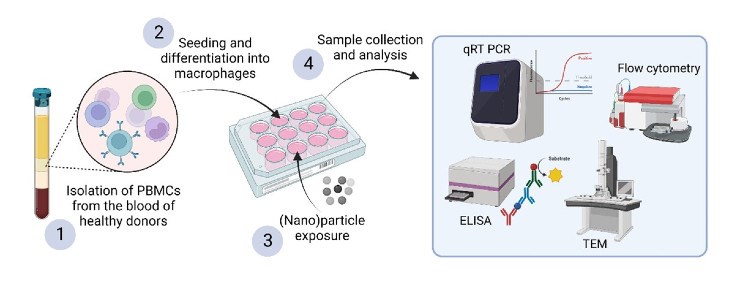Primary monocyte derived macrophages as a model to study chronic low-grade inflammation
This project aims to develop an alternative chronic inflammatory cell model using primary monocyte-derived macrophages exposed to engineered (nano)particles. Human primary monocyte-derived macrophages can survive for a long time in cell culture and is therefore a promising alternative as a chronic inflammatory model.
Research aims
The project will follow the inflammatory response for several weeks, and aim at identifying several aspects of the cell response to the inflammatory stimuli, including: 1) phenotypic characterization of M1/M2 markers by the means of surface marker analysis using flow cytometry, and through qRT PCR of key inflammatory gene transcripts; 2) classic inflammatory markers of inflammation, e.g. release and mRNA transcript of IL-1b, TNF-a, IL-10 and IL-6 and IL-8; 3) cell imaging together with Vironova AB using transmission electron microscopy (TEM) imaging in order to observe (nano)particle internalization and changes over time in morphology of organelles, (nano)particle compartmentalization, or cellular mechanisms playing role in inflammation, such as autophagosome formation or effects on the integrity of mitochondria.

Expected outcomes
We expect to develop a cell culture model describing how macrophages react during chronic inflammation triggered by low-dose (nano)particle exposure. Macrophages are persistent tissue resident cells that are important players shaping the local inflammatory environment, and that have the potential to both drive and inhibit inflammation. Thus, understanding how the macrophages act during chronic inflammation is a key part to understand how the chronic inflammation is sustained and how it could be resolved. The model could be used in further X-HiDE projects, and in projects on nanotoxicology, which is a growing field at the Örebro University.
Key personnel
Alexander Hedbrant, iRiSC
Andi Alijagic, iRiSC and MTM
Ida-Maria Sintorn, Vironova AB
Project duration
September 2022 – February 2023
